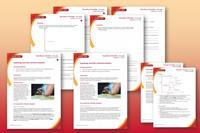The bombardier beetle has an explosive chemical defence mechanism. The reaction that occurs in its abdomen is a catalysed exothermic reaction
This resource accompanies the Education in Chemistry article Wonder weapons where you can read about even more bugs with chemical superpowers.
Learning objectives
- Draw an energy level diagram for both a catalysed and uncatalysed reaction.
- Explain the effect of catalysts on the profile of a reaction.
Introduction
Energy changes in reactions can be described as exothermic and endothermic. Endothermic reactions absorb energy from the surroundings and exothermic reactions release energy to the surroundings.

There are lots of examples of animals across nature which rely on chemicals or a mixture of chemicals to help them avoid being eaten. Some spray acid whereas some spray oils. However, the bombardier beetle is slightly different. In this activity learners will read an excerpt from the article Wonder weapons published in Education in Chemistry and then use their knowledge to answer questions on exothermic reactions, the effect of catalysts and balancing equations.
Differentiation
There are two differentiated versions of the student worksheet. In the unscaffolded version, learners are expected to be able to draw a sketch graph including their own axes. In the scaffolded version, the axes are already drawn, as are the start and end points. Learners will add labels to the axes and complete the reaction profiles. Further scaffolding includes fill-in-the-gap answers, while the unscaffolded worksheet requires learners to write their own sentences.
Answers covering both worksheets are provided in the teacher notes.
More resources
- Use these tips to boost student understanding of energy transfer and show more examples of how exothermic reactions go beyond simply combustion.
- Devise an experiment to investigate how catalysts affect rate of reaction in this lesson plan for 14–16 year olds featuring the Kursk submarine.
- Link catalysts to enzymes by conducting an investigation into the decomposition of hydrogen peroxide.
- Find out how studying ant communication and defences could lead to new antibiotics, with this article and reading comprehension.
Downloads
Superbugs - student sheet
Handout | PDF, Size 0.29 mbSuperbugs - scaffolded student sheet
Handout | PDF, Size 0.29 mbSuperbugs - teacher notes
Handout | PDF, Size 0.38 mbSuperbugs - student sheet
Editable handout | Word, Size 0.59 mbSuperbugs - scaffolded student sheet
Editable handout | Word, Size 0.62 mbSuperbugs - teacher notes
Editable handout | Word, Size 0.52 mb



















No comments yet